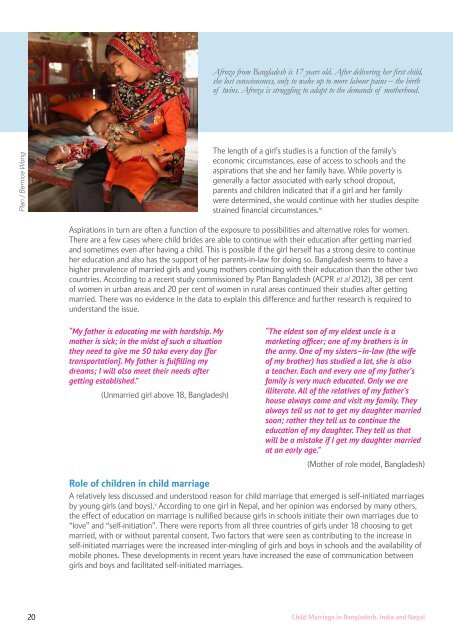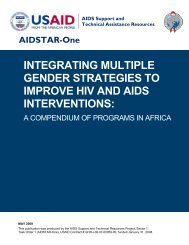Asia Child Marriage Initiative: Summary of Research in ... - ICRW
Asia Child Marriage Initiative: Summary of Research in ... - ICRW
Asia Child Marriage Initiative: Summary of Research in ... - ICRW
Create successful ePaper yourself
Turn your PDF publications into a flip-book with our unique Google optimized e-Paper software.
Afroza from Bangladesh is 17 years old. After deliver<strong>in</strong>g her first child,<br />
she lost consciousness, only to wake up to more labour pa<strong>in</strong>s – the birth<br />
<strong>of</strong> tw<strong>in</strong>s. Afroza is struggl<strong>in</strong>g to adapt to the demands <strong>of</strong> motherhood.<br />
Plan / Bernice Wong<br />
The length <strong>of</strong> a girl’s studies is a function <strong>of</strong> the family’s<br />
economic circumstances, ease <strong>of</strong> access to schools and the<br />
aspirations that she and her family have. While poverty is<br />
generally a factor associated with early school dropout,<br />
parents and children <strong>in</strong>dicated that if a girl and her family<br />
were determ<strong>in</strong>ed, she would cont<strong>in</strong>ue with her studies despite<br />
stra<strong>in</strong>ed f<strong>in</strong>ancial circumstances. iv<br />
Aspirations <strong>in</strong> turn are <strong>of</strong>ten a function <strong>of</strong> the exposure to possibilities and alternative roles for women.<br />
There are a few cases where child brides are able to cont<strong>in</strong>ue with their education after gett<strong>in</strong>g married<br />
and sometimes even after hav<strong>in</strong>g a child. This is possible if the girl herself has a strong desire to cont<strong>in</strong>ue<br />
her education and also has the support <strong>of</strong> her parents-<strong>in</strong>-law for do<strong>in</strong>g so. Bangladesh seems to have a<br />
higher prevalence <strong>of</strong> married girls and young mothers cont<strong>in</strong>u<strong>in</strong>g with their education than the other two<br />
countries. Accord<strong>in</strong>g to a recent study commissioned by Plan Bangladesh (ACPR et al 2012), 38 per cent<br />
<strong>of</strong> women <strong>in</strong> urban areas and 20 per cent <strong>of</strong> women <strong>in</strong> rural areas cont<strong>in</strong>ued their studies after gett<strong>in</strong>g<br />
married. There was no evidence <strong>in</strong> the data to expla<strong>in</strong> this difference and further research is required to<br />
understand the issue.<br />
“My father is educat<strong>in</strong>g me with hardship. My<br />
mother is sick; <strong>in</strong> the midst <strong>of</strong> such a situation<br />
they need to give me 50 taka every day [for<br />
transportation]. My father is fulfill<strong>in</strong>g my<br />
dreams; I will also meet their needs after<br />
gett<strong>in</strong>g established.”<br />
(Unmarried girl above 18, Bangladesh)<br />
“The eldest son <strong>of</strong> my eldest uncle is a<br />
market<strong>in</strong>g <strong>of</strong>ficer; one <strong>of</strong> my brothers is <strong>in</strong><br />
the army. One <strong>of</strong> my sisters–<strong>in</strong>-law (the wife<br />
<strong>of</strong> my brother) has studied a lot, she is also<br />
a teacher. Each and every one <strong>of</strong> my father’s<br />
family is very much educated. Only we are<br />
illiterate. All <strong>of</strong> the relatives <strong>of</strong> my father’s<br />
house always come and visit my family. They<br />
always tell us not to get my daughter married<br />
soon; rather they tell us to cont<strong>in</strong>ue the<br />
education <strong>of</strong> my daughter. They tell us that<br />
will be a mistake if I get my daughter married<br />
at an early age.”<br />
(Mother <strong>of</strong> role model, Bangladesh)<br />
Role <strong>of</strong> children <strong>in</strong> child marriage<br />
A relatively less discussed and understood reason for child marriage that emerged is self-<strong>in</strong>itiated marriages<br />
by young girls (and boys). v Accord<strong>in</strong>g to one girl <strong>in</strong> Nepal, and her op<strong>in</strong>ion was endorsed by many others,<br />
the effect <strong>of</strong> education on marriage is nullified because girls <strong>in</strong> schools <strong>in</strong>itiate their own marriages due to<br />
“love” and “self-<strong>in</strong>itiation”. There were reports from all three countries <strong>of</strong> girls under 18 choos<strong>in</strong>g to get<br />
married, with or without parental consent. Two factors that were seen as contribut<strong>in</strong>g to the <strong>in</strong>crease <strong>in</strong><br />
self-<strong>in</strong>itiated marriages were the <strong>in</strong>creased <strong>in</strong>ter-m<strong>in</strong>gl<strong>in</strong>g <strong>of</strong> girls and boys <strong>in</strong> schools and the availability <strong>of</strong><br />
mobile phones. These developments <strong>in</strong> recent years have <strong>in</strong>creased the ease <strong>of</strong> communication between<br />
girls and boys and facilitated self-<strong>in</strong>itiated marriages.<br />
20 <strong>Child</strong> <strong>Marriage</strong> <strong>in</strong> Bangladesh, India and Nepal

















